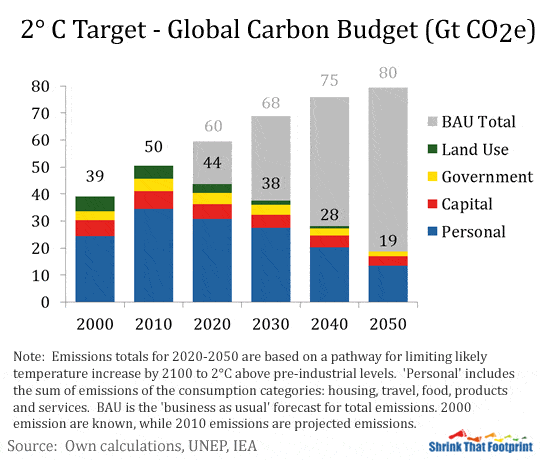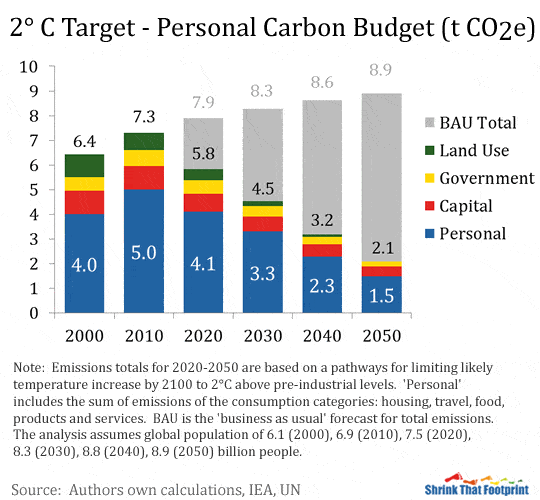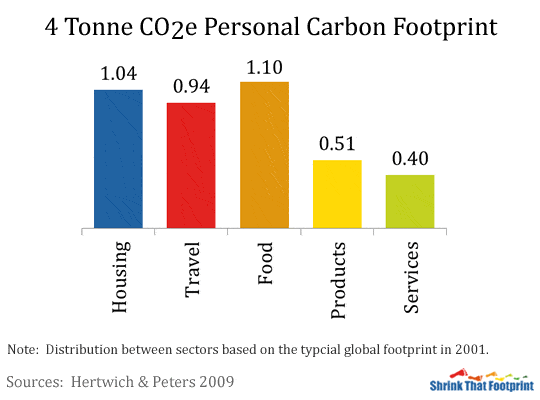Carbon Footprint Targets And Personal Carbon Budgets
This is a high level guide to give our readers more clarity about the way to reduce their carbon budget in the context of the global carbon budget. We introduce two important concepts: carbon footprint targets and personal carbon budgets. Every time you reduce your footprint it is a step in the right direction. The first changes, however simple, can be the start of a process that reduces your carbon footprint to a level consistent with a stable climate. Understanding what is your carbon footprint target and personal carbon budgets will let you set measurable goals for shrinking your carbon footprint.
This step will look at a global carbon budget, personal carbon budgets, potential to shrink, starting to shrink and carbon footprint targets.

First: The Global Carbon Budget
This step brings together ideas from the first two steps of this guide. In the first step we described the global carbon footprint and how it can be split into personal, capital, government and land use emissions. In the second step we discussed an emissions pathway that was consistent with keeping warming below 2°C (3.6°F). By combining these two ideas we can create a global carbon budget consistent with limiting warming to 2°C (3.6°F) and then work back from there to an individual budget.
The 2°C (3.6°F) emissions pathway in the last step is a bit easier to think about if we translate it into targets for certain dates, hence creating a carbon budget. To help analyse these budgets further we can split global emissions into consumption sectors: personal, capital, government and land use.
It looks like this:

This global carbon budget is one consistent with a pathway that is likely to keep warming, above the pre-industrial level by 2100, to less than 2°C (3.6°F) . For reference it also includes a business as usual (BAU) forecast to help understand the scale of these emission reductions. Under this budget global emissions reduce from 50 Gt CO2e in 2010 to 19 Gt in 2050. This is in sharp contrast to the BAU scenario in which they rise to 80 Gt CO2e in 2050.
This budget includes a number of ambitious assumptions, that on current trends look unlikely to occur. In it personal emissions decline more than 60% between 2010 and 2050 from 34.5 Gt to 13.3 Gt, or at a yearly rate of about 2.4%. Government emissions are reduced by 75% from 4.5 Gt to 1.7 Gt at a rate of 3.5% per annum. Capital emissions fall much less quickly from 6.6 Gt in 2010 to 3.6 Gt in 2050, equating to a 45% drop over the period or an annual decline of 1.5%. The slower improvement in capital emissions assumes that any low carbon transition will require considerable investment in construction and machinery, both of which are relatively difficult to decarbonise at any great speed. Finally land use emissions decline from around 5 Gt to zero net emissions by 2050.
These figures are not a forecast. Instead they are an indication of the scale of cuts needed to meet a 2°C target, based on current scientific understanding. Whereas the business as usual scenario provides a forecast of how emissions are expected to grow in the absence of a large scale transition away from fossil fuels.
To make this global budget more tangible to the individual we will translate to an individual budget.
Now Consider A Personal Carbon Budget
By keeping the global budget in terms of personal, capital, government and land use emissions, the transition to a personal carbon budgets is made very easy. We simply divide the global budget by expected population in each budget period. This gives us a personal carbon budget for the 2°C target.
It looks like this:

In this budget per capita emissions decline from 7.3 t in 2010 to around 2.1 t in 2050, a reduction of 71% or more than 3% each year. This is in contrast to the business as usual projection of 8.9 t in 2050. Since this budget is derived from the global budget reductions in per capita emissions are even more ambitious, due to the assumed population growth from around 7 billion in 2010 to almost 9 billion in 2050.
For the individual the most interesting number is the personal carbon budget, that is the combined emissions from personal spending on housing, travel, food, products and services. The personal carbon budget falls by almost a tonne each decade, beginning at 5 t in 2010 and dropping to 1.5 t by 2050.
Given that average personal emissions in 2010 were around 5 tonnes per person reducing them to 1.5 tonnes by 2050 is very ambitious. Yet this is exactly the sort of reduction the science dictates we must make in order to keep warming this century below 2°C (3.6°F). Whether these reductions are technically, economically and socially viable are all very good questions. It is the answers to them which will decide the future path of emissions.
The personal budgets given here are based on an equal sharing of emissions across the global population. Based on equity concerns, and historical emissions, there is a very good argument for differentiating such budget in favour of the poor, though we will not address that argument here. Instead it is worth pointing out that much of the potential capacity to reduce emissions lies with wealthy people. This is because wealthier individuals tend to have both large personal footprints and the financial capacity to reduce them with relative ease.
Next, Imagine The Potential To Shrink: Carbon Footprint Targets
If you personal footprint is 20t it shouldn’t be all that difficult to reduce it to 15t, a reduction equivalent to an average personal footprint in 2010. On the other hand reducing your personal footprint from 10 t to 5 t could involve quite a lot of changes and some difficult sacrifices. Finally, reducing it from 6t to 1t may be very difficult indeed and could greatly limit all aspects of your housing, travel, food, products and service consumption.
The bigger your footprint is the more potential you have to shrink it. Much of this potential is located in wealthy countries, and more specifically with wealthy people, who often have both large footprints and a means to reduce them.
Using the same study as in the first step we can look at average personal footprints in major countries in 2001. These footprints are the sum of housing, travel, food, product and service emissions, so they exclude the capital, government and land use emissions that don’t result from personal expenditure.
They look like this:

The average person in the US, Canada and Australia has great potential to shrink his or her personal footprint. Even a footprint as big as 15 tonnes will go down significantly just by work on the major parts of the footprint. These are typically car travel, heating, electricity use and flying.
The converse is naturally true for those with very small footprints. Those with very small personal footprints lack access to electricity, motorised transport, adequate clothes and furnishings. Rather than shrink their footprints these people need instead to increase them as part of improving their living standard. The average footprint in China is a good example. Although it was around 1.7 t in 2001 it is likely to grown to around 4 t by 2010. The upward trend is spurred on by rapid economic growth and improving living standards.
National averages hide the power of individual action. The potential to shrink your footprint is much more about the size of your footprint than where you live. If you have a 30t personal footprint you should be able to make enormous reductions regardless of your location. Focus on heating and cooling and access to low carbon electricit. If you can afford a large footprint you can certainly afford access to alternatives and technologies to reduce the footprint.
The graph tempts us to think that there is a perfect correlation between wealth and personal emissions. It suggests that we can’t have both a high standard of living and low emissions. While there is a relationship between the two, wealth and emissions are not the same thing. The size of a personal footprint depends quantity as well as method of consumption.
In each category of housing, travel, food, products and services we find substitutes that are far less carbon intensive. To reduce our footprint we need to get our kilowatt-hours, kilometres, calories, products and services from low emission sources. In cases where we can’t find low carbon alternatives, reducing our footprint involves consuming less or differently. This is more challenging.
Finally, Starting To Shrink
Although in the longer term setting targets for your footprint make sense, to begin with you just need to start. You really won’t know how much you can shrink until you try. As you experiment with different ways of reducing your footprint you will quickly see how practical your different options are.
To understand your own footprint you first need to calculate it. Getting an accurate estimate of your footprint is not easy. The better you measure it the more effectively you will be able reduce it. The next step of this guide provides a method for calculating your footprint. This methodology explains how a thorough footprint calculation will capture all emissions. The emissions fall into categories of housing, travel, food, product and service needs.
When you try to shrink you footprint the most important thing to keep in mind is scale. As sensible as it to unplug your phone charger, boil only the water you need or defrost your fridge, small scale changes will only deliver small scale results. Targeting just one large part of your own footprint may be much more fruitful.
The first time you do a thorough calculation of your personal carbon footprint there are likely to be a few large parts of it that catch your eye. Heating, electricity use, driving, flying, red meat (for example giving it up for vegan including thinking through holiday meals) or electronic purchases can easily be more than a tonne by themselves. Targeting these large components will be the easiest way to make significant reductions.
Reducing emissions comes down to the choice between doing something less carbon intensive or doing it less. For electricity supply, heating and car travel, less carbon intensive options are widely available. On the other hand, plane flights, certain foods and manufactured products the alternatives are limited. As a result reaching a very low carbon footprint often requires a mix of both technology and changes in behaviour.
Steps six to nine of this guide focus on reducing our footprints in each consumption sector. The sectors are housing, travel, food, products and services. The usefulness of these ideas depend many factors. These factors include the composition of your footprint, whether you own or rent, willingness to use new technologies, access to public transport and level of motivation. Addressing products is covered by the concept of zero-waste swaps.
In the short term it just make sense to start shrinking your footprint and see where it leads you. If you were to reduce your personal footprint from 15 t to 10 t that would represent a very large 5 t reduction. If replicated on a large scale this would really add up. In the longer run stabilising the climate requires personal footprints to become quite small. We will look at two personal budgets in particular: a near term goal of 4 t CO2e and a longer term goal of 1 t CO2e.
Shrinking To A Four Tonne Carbon Footprint Target
Earlier in this step we calculated a personal carbon budget based on the goal of limiting temperature change by 2100 to 2°C (3.6°F) . In it the personal budget declines from 5 t to 1.5 t CO2e between 2010 and 2050. Although such reductions seem unlikely, compared to the business as usual scenario, they are what is needed to meet a mitigation target consistent with staying within 2°C (3.6°F) of warming.
The personal carbon budget we calculated for 2020 is about 4 t CO2e. This makes an excellent target for the near term.
If your personal footprint is more than 10 t then getting down to 4 t is going to be difficult, but it is certainly possible. In fact in the year 2000 4 t CO2e was roughly the global average personal footprint. In it the dominant sectors were housing, travel and food. Based on that global average a 4 t footprint might look something like this:

If the average person lived like this in 2000, such a lifestyle is more than possible. The better question is how desirable is it? Given current technology living a 4 tonne lifestyle involves restrictions. These restrictions many people wouldn’t enjoy, particularly in terms of travel, food and products.
So what does a 4 tonne lifestyle look like? A 4 t personal footprint is about a fifth of a the typical American personal footprint. Using data from US we estimate roughly what 4 tonnes would provide. We break it down into our categories of consumption. In each case it would provide these things for each person per year, and nothing else.
Housing: 1.04 t = 1500 kWh of US grid electricity
Travel: 0.94 t = 2000 miles driving at 20 MPG
Food: 1.1 t = a mostly vegan diet with limited food waste
Products: 0.51 t = $1000 worth of products
Services: 0.4 t = $2000 worth of services
It is pretty obvious that given the means most American’s choose a very different lifestyle to this. It is tempting to think 4 tonnes is a completely unrealistic target. The complaint is that such a lifestyle is hugely restrictive. But therein lies the challenge.
Incidentally we get strange questions from our readers one of whom who asked whether petroleum is considered vegan. Apparently the connection is that dead organic material gives rise to petroleum is vegan people technically shouldn’t be using petroleum. However, we argued that the connection is separated by millions of years and hard to draw a line from the suffering of any one animal to the petroleum end product. In fact, the animals died very naturally without any human intervention!
Restricting home electricity to hydro, nuclear, wind or solar you could get 20,000 kWh from a 1 t footprint. Compare a hybrid car and an electric car. The first might deliver 5000 miles of driving for 1 t. The second could deliver more than 10,000 miles, even allowing for its higher manufacturing emissions.
Broadening ones diet within a 1t budget on the other hand is tougher. You would need to choose what you eat carefully while reducing waste. Reduce carbon footprints from product purchases by buying used goods. Buy goods with less carbon intensive design and harboring more recycled material. Finally the carbon footprints of services can be dramatically reduced by service providers if they choose to do so.
This example shows that to shrink our footprints we need to consume less carbon intensively or simply consume less. To reach a 4t target CO2e from 10 t you will need to combine tactics. Meeting a long term budget of 1t CO2e is far more challenging.
Shrinking To A One Tonne Carbon Footprint Target
In the personal carbon budget to limit warming by 2100 to 2°C (3.6°F) the 2050 target for personal emissions is 1.5 t CO2e . This footprint is closing in on the idea of a 1 tonne footprint, which is the type of footprint that could allow global concentrations of greenhouse gasses in our atmosphere to stabilise.
In our global budget example for 2050, total personal, government, capital and land use emissions are equal to a global footprint of 19 Gt CO2e. This is approaching the global footprint we might need to stabilise concentrations of greenhouse gasses in the atmosphere. The actual value in the future will depend on the mix of gasses and the performance of our natural sinks. The 1 t personal footprint is a good guide for the type of action needed to put us on a path to a stable climate.
We could also create an example of what a 1 tonne budget would allow with today’s technology. This budget would devote a large part of the footprint to the providing a quite restricted diet. All electricity, heating and cooling would need to come from low carbon sources. All transport would be either walking, cycling or electrified public transport. The remaining budget would be used for a small number of service and product purchases.
Although reaching a 1 tonne budget is technically possible today, it is a very restrictive target. By 2050 however, the carbon intensity of all types of consumption should have improved dramatically. We should able to provide far more housing, travel, food, products and services within any carbon budget. Indeed, some forms of consumption may have net negative emissions, like if biomass electricity with carbon capture becomes viable.
Despite its restrictions, the 1 tonne target is an excellent long-term goal. It will help us understand the technologies we need. Technologies will be needed in order to limit our fossil fuel use. As such it makes an excellent aspirational goal. Nonetheless, maintaining a good standard of living using only 1 t CO2e per year would be truly pioneering.
Summary
In this step we have shown a global carbon budget consistent with limiting climate change by 2100 to 2°C (3.6°F).
We converted this global budget into personal carbon budgets which are more useful for individuals. Following, we discussed why people with large personal footprints have the most potential to shrink them. We explained why to begin with it is better to just start shrinking rather than focusing on targets. Finally we looked at the near term and long term carbon footprint targets. We considered targets of 4 t CO2e and 1 t CO2e, to help understand the scale of the challenge.
In the next step we discuss how to calculate your carbon footprint.
Lindsay Wilson
I founded Shrink That Footprint in November 2012, after a long period of research. For many years I have calculated, studied and worked with carbon footprints, and Shrink That Footprint is that interest come to life.
I have an Economics degree from UCL, have previously worked as an energy efficiency analyst at BNEF and continue to work as a strategy consultant at Maneas. I have consulted to numerous clients in energy and finance, as well as the World Economic Forum.
When I’m not crunching carbon footprints you’ll often find me helping my two year old son tend to the tomatoes, salad and peppers growing in our upcycled greenhouse.
